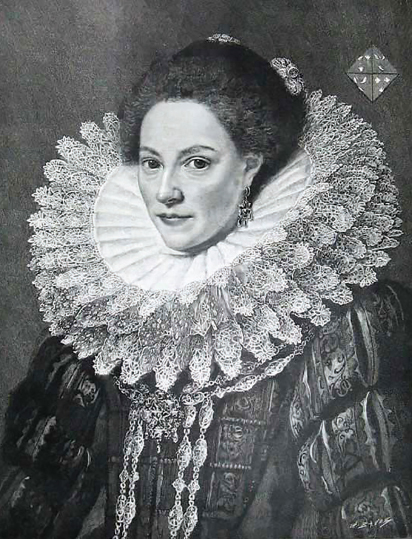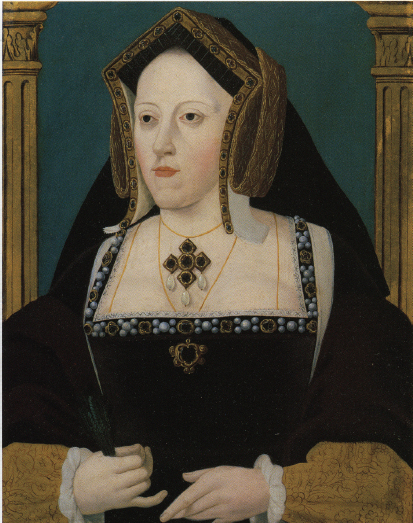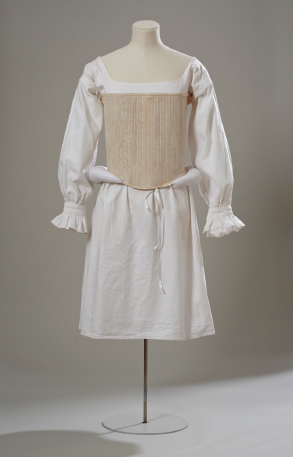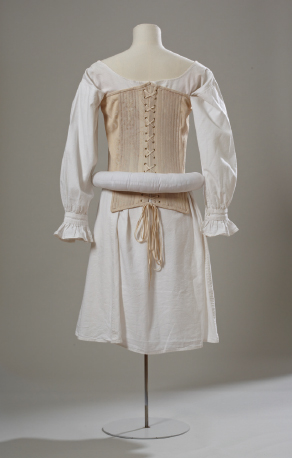
Drums and Wheels
‘The women, when they have all these goodly robes upon them, seem to be the smallest part of themselves, not natural women, but artificial women; not women of flesh and blood, but rather puppets or mawmuts, consisting of rags and clouts compact together.’
Stubbes, The Anatomie of Abuses
Keeping one’s head upon one’s neck had been a major concern for those connected to the Tudor court, and as the days of Henry VIII waned and the golden age of his daughter Elizabeth dawned the throat became once more the focus of attention. It was not so much a question of the neck being exposed upon a block, but it being completely concealed. Along with the Spanish farthingale, the wasp-waist corset and trunk hose, the ruff is possibly the first item that springs to mind when people consider Elizabethan costume. Large ruffs were the despair of laundresses as often these were held away from the wearer’s face by hundreds of carefully inserted sticks of wood or bone, and could only be worn once before they had to be washed, ironed and refolded, the tiny sticks painstakingly reinserted. This was to change in 1564 with the arrival of Mistress Dinghen Van Der Plasse, who essentially taught the English how to make starch – a word derived from Middle English ‘sterchen’ meaning to stiffen.
Despite its preposterous dimensions during its heyday, the ‘ruff’ had humble beginnings when in the 1530s and 40s it was no more than a simple frill on the collar and cuffs of a chemise. As the fashion became popular and independent of other garments ruffs could be washed, starched and set into elaborate figure-of-eight folds by using cone-shaped goffering irons, and setting-sticks. ‘Poking-sticks’ were heated in the fire and applied to the folds of the ruff, in effect ironing it into the precise symmetry so admired in the 1500s. Starch began to be used, but only on a small scale and with some recipes being more successful than others. It was only after the young refugee Mistress Dinghen Van Der Plasse had fled her native Flanders for her ‘better safetie’ and settled in London’s Cheapside that starch-making underwent a revolution. Tutored since the age of 12 in the art of ruff-making by her late father, she used her extensive needlework skills to create ruffs stiffened with starch taken from a secret recipe which used as its main agent the bluebell plant. Soon her new ‘clear’ starch was in great demand as it did not clog-up the loose weave of delicate muslins and other fabrics with unsightly granules, giving her ruffs a much-desired crisp finish.
Mistress Van Der Plasse became a very successful business woman. Patronised by Queen Elizabeth’s household which employed her methods, it wasn’t long before starching houses sprang up all over England despite religious conservatives branding her worse than a witch and her clear-starch mixture the ‘Devil’s broth’. Women in general who had made their own ruffs took the liberty of sending them to her workshop in order for them to be starched, as observed by one London resident:
Ruffs became ‘monstrous’ in size and were legislated against in Tudor England. From Illustrated London News, 1858. (Author’s collection)
The most curious wives now made for themselves ruffs of cambric, & sent them to Mrs Dinghen to be starched, who charged high prices; after a time made themselves ruffs of lawn; & thereupon arose a general scoff or by-word that shortly they would make their ruffs of spiders’ web. Mrs Dinghen at last took their daughters as her pupils; her usual terms were four or five pounds for teaching them to starch, & one pound for the art of seething starch.
Of course, where there are means extravagance often follows, born out by the enormous lengths (and breadths) the ruff went on to assume. One particular gauzy creation was all of ‘a quarter of a yard’ but appeared to be something designers were reluctant to claim. In England it was commonly known as the ‘French Ruff’, whereas in France it was referred to as ‘the English Monster’! At their most extreme, ruffs were a foot or more wide and needed a wire frame called a supportasse or underpropper to hold them at a fashionable angle. Of course, there were those who deplored the fashion and, as one would expect, the Puritan Philip Stubbes made his views known in 1583 in The Anatomie of Abuses:
The women use great ruffes, & neckerchers of holland, lawne, camerick, & such cloth, as the greatest thred shall not be so bigge as the leasthaire that is: then, least they should fall down, they are smeared & starched in the devils liquore, I meane Starch: after that, dryed with great diligence, streaked, patted & rubbed very nicely, & so applyed to their goodly necks, &, withall, underpropped with supportasses (as I tolde you before) the stately arches of pride: beyond all this they have a further fetch, nothing inferiour to the rest; as, namely, three or foure degrees of minor ruffes, placed gradatim, step by step, one beneath the other, & all under the Maister devil ruffe. The skyrts, then, of these great ruffes are long & wide every way, pleated & crested ful curiously, Godwot.
Ecclesiastics were not enamoured with them either with the Bishop of London, John King, condemning them from the pulpit with, ‘Fashion brought in deep ruffs & shallow ruffs, thick ruffs & thin ruffs, double ruffs & no ruffs. When God shall come to judge the quick & the dead, he will not know those who have so defaced the fashion he hath erected’. The Revd Hall, Bishop of Exeter, finishing a sermon on the vanities of ‘farthingales, feathers, and paint’ concluded with, ‘Hear this, ye popinjays of our time; hear this, ye plaster faced Jezabels: God will one day wash them with fire & with brimstone.’
Towards the end of the 1500s, fashion dictated a more feminine fan-shaped ruff, which was achieved by opening the ruffle in front to expose the neck and cleavage. This was often constructed on gauze wings raised at the back of the head which allowed greater movement of the neck. As sour as always, Philip Stubbes’ Puritan outlook caused him to comment on this openly seductive accessory: ‘Sometimes they are pinned up to their eares, sometimes they are suffered to hang over their shoulders, like windmill sayles fluttering in the winde; & thus every one pleaseth herself with her foolish devices, for as the proverb saith: “everyone thinketh his own wayes best”.’
Condemnation is rarely a reason for the fashion conscious to conform to the norm and so Queen Elizabeth eventually legislated against various items of dress, for example, ruffs and rapiers that served to over-inflate the egos of many of her subjects. At one point there were even studious and sober citizens placed at each one of London’s city gates to cut the ruffs and to break off rapier points of all that exceeded a yard’s length or a ‘nail of a yard’ in the depth of their ruffs. It appears that in France laws were not as stringent, as it was rumoured that in 1579 Queen Margot, 1st wife of Henry IV of France (1533–1615), when seated at dinner, was obliged to have a spoon with a handle 2ft long for the purpose of passing her soup over her ruff, so as to keep it rigid and immaculate.
The ruff, as well as being perhaps the most recognisable item of the Elizabethan age, dictated the hairstyles of both men and women, most famously short hair for men with a pointed beard, and provided a perfect frame for the face; a face enhanced by what can only be described as deadly make-up. With the Tudors believing that ‘outward beauty was a true sign of inner godliness’, Elizabeth I’s first appearance on the world stage saw her appear as a virgin queen with her hair flowing and an alabaster complexion, the latter being the result of white lead make-up also known as ceruse. The cult of Gloriana had arrived.
Elizabeth knew that beauty was powerful and inspired devotion in return, which, due to a turbulent and insecure childhood, she craved. It was not enough for her to be queen she wanted to be seen to be queen which in an age devoid of media meant she often rode among her people, her face perfectly painted. This was an invitation to her subjects to love her and therefore be less inclined to rebel against her. It was Elizabeth’s aim to make herself more than a weak and feeble woman and using cosmetics was part of the ruse. Just as her father had famously put himself above the Church, in this matter so did Elizabeth. The Church decried the use of make-up and Philip Stubbes in The Anatomie of Abuses echoed the stance the Church took on such things: ‘a woman through painting and dying her face, sheweth herself to be more then [sic] whorish. For she hath corrupted and defaced (like a filthie strumpet or brothel) the workmanship of God in her …’.
Queen Elizabeth portrayed as ‘Wisdom’ in an antique print, 1898. (Author’s collection)
Elizabeth was determined to cover the scars she had received from her bout of smallpox in 1562 and so defied those that condemned cosmetics and became a devotee of the smoothing coverage of white lead. There were other powders available, such as ground alabaster or starch, but they did not produce the perfect luminosity she favoured nor gave the coverage she needed. Rouge, usually of red ochre, would be applied to re-introduce the faded bloom of youth, and lips would be coloured with a ‘crayon’ of ground alabaster or plaster of Paris mixed with either cochineal or dyes from the East Indian brazil tree, all mixed together and dried into sticks in the sun. An egg-white glaze was finally applied, covering everything with a porcelain-like shine. Cosmetics were usually home-made but there were ready-made products to be had, some infused, so it was rumoured, with magical powers. There was even a sixteenth-century ‘chemical peel’ advocated by physician and alchemist Ruscelli. He recommended that a woman use eggs, vinegar, turpentine, camphor, rock alum, quicksilver, lemon juice, tartarum and white onion mixed into a paste and applied to the neck, breast and face letting it ‘drie of itself, at night when you goe to bedde …’. There was, however, a drawback as the concoction had to be left in place for no less than ‘eight daise …’ then removed via another complicated recipe before steaming the face.
Elizabeth firmly believed that beauty and strength were one and the same and so thought England’s success as a nation was a reflection of her ability to be beautiful. To stay so she employed more and more ceruse which ironically ate into the flesh it was supposed to be smoothing, forcing her to poison that on which, in her eyes, England depended.

Catherine of Aragon (1485–1536) in the ‘Gable Hood’ of the late Medieval and early Tudor period. Artist unknown. (Author’s collection)
Just as the verdingale had dictated the female shape from its introduction in England by Catherine of Aragon seventy years previously, by 1577 a new version of the farthingale had been sent to the Queen and came to embody the Elizabethan era. Called the half-farthingale, it was a design that allowed the front of the dress to fall flat while only the sides and back of the dress were filled out. Known to be a thrifty housekeeper, Queen Elizabeth resisted having too many new outfits made, preferring instead to have many of her old farthingales altered and on many occasions repaired. Her Wardrobe Accounts feature many entries for payments made to various dressmakers and seamstresses, not least her favourite tailor Robert Sibthorpe, who in 1586 was paid for ‘alteringe enlarginge & styffenynge of seven half verthingalls iii of satten’ and again in 1591 paid for ‘alteringe and newe coueringe of iiii half verthingales of Taffata with whales bones’. Though generally constant in shape, farthingales were often widened requiring more panels to be added, or decreased with panels being removed.
The last style of the farthingale before its demise in the early decades of the seventeenth century was the ‘cart-wheel’, ‘Catherine-wheel’ or ‘drum’ farthingale. As England stood proud in her achievements as a nation so too this strange skirt stood proud of the body, surrounding it in a stiff, unyielding circle before allowing the costume to fall vertically to the ankles. It is described by Jane Ashelford in her book The Art of Dress:
The structure carried the skirt out to right angles from the waist to a width varying from 8 to 48-inches before falling vertically to the ground. To avoid the hard line made by the rim of the wheel farthingale, the skirt was given a circular frill or flounce, the pleats of which radiated out from the centre to the edge of the rim. The whole skirt was then tilted at the waist so that the hem was raised at the back and lowered in the front. Wearing the farthingale at this angle allowed the wearer to rest her hands on the ledge-like surface of the flounce …
The way in which this farthingale was worn created the illusion of a long torso and shorter legs, which alluded to, in the case of younger women, a childbearing figure. To add to the illusion and help support the creation and keep it stable it was worn over a bum-roll. Lower class women wore a much larger bum-roll to imitate the fashion of the higher classes as they could not afford a full farthingale. Lastly, it was worn under what we today have come to know as a corset but before the eighteenth century in England (the French were using the word as early as 1611) was called a ‘pair of bodies’, the name thought to originate from a time when the garment was actually two separate parts laced together front and back. In 1577 an account by Jerome Lippomano, a French ambassador, documented the inconceivably narrow waists of his native French women, commenting on how they swelled out their gowns from the waist downwards ‘by whaleboned stuffs and vertugadins, which increases the elegance of their figures. Over the chemise they wear a corset of bodice, that they call a ‘corps pique’, which makes their shape more delicate and slender. It is fastened behind which helps to show off the form of the bust.’ Proof that the purpose of the ‘bodies’ was to support and flatten the front of the torso.

A cone-shaped bodice typical of the Tudor period and seen here with a bum-roll. (Photograph Tessa Hallmann)

Back view. (Photograph Tessa Hallmann)
It has become the norm to think of a ‘pair of bodies’ (corset) as an Elizabethan undergarment but this was not strictly the case, the only real underwear being the shift or chemise. Bodies were worn under other garments, but not as nineteenth-century corsets were worn, crisp, white and never meaning to be seen. The rich, able to wear multiple finely decorated layers, would have worn a doublet over the corset when receiving any but the most intimate visitors. The middle classes, on the other hand, wore the bodies as a top garment with the addition of sleeves and a cloak, if necessary, when they went out. Decorated and made from attractive coloured fabrics, they were intended to be seen.
Wearing a farthingale necessitated certain ways of holding oneself as the stiffness of Elizabethan clothing made a relaxed posture impossible. A lady could rest her wrists upon the edge, or upon the swell of the garment with arms held away from the body and her elbows bent outward to emphasise a narrow waist. Corsets pushed the breasts high and the shoulders back forcing the head into a poised position often mistaken as haughty. Though it may seem unacceptable to us today to accept such uncomfortable costumes, the sixteenth-century woman knew no different and so accepted what she wore as the norm.
Throughout the use of the farthingale, sitting was generally a difficult matter; chairs were simply not wide enough, so cushions were used. Skirts and farthingale were lifted over the pile of cushions and then the lady was free to sit down, encompassed by the skirts. At a party held by Queen Elizabeth in May of 1559 many of her ladies-in-waiting had to sit on the ground because of the lack of room at the table. An observer of the feast wrote:
The supper hour having arrived … The Queen, having washed her hands, and being at table under her canopy, insisted on having M. de Mountmorency at her little table … At the large table all the rest of the French lords and gentlemen sat on one side, and on the other all the ladies, of whom there was no small number, and who required so much space on account of the farthingales they wore that there was not room for all; so part of the Privy Chamber ate on the ground on the rushes, being excellently served by lords and cavaliers, who gave them courage and company at their repast.
Costume did eventually dictate the design of furniture and the farthingale chair was created. This was an armless chair with a wide seat covered in high-quality fabric, fitted with a cushion and a backrest with an upholstered panel. Able to accommodate a woman’s wide skirts, it was one of the earliest comfortable upholstered seats introduced as a lady’s chair in the late sixteenth century, though not named until much later in the nineteenth century. An earlier English name was ‘imbrauderer’s chair’ or ‘upholsterer’s chair’.
